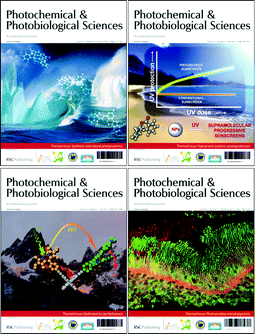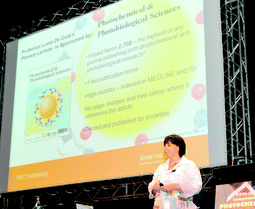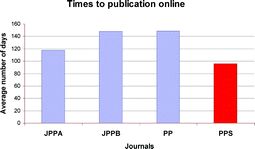Welcome to the 2011 volume of Photochemical & Photobiological Sciences
Ownership and Editorial Boards
During 2010 there have been a number of changes to the Photochemical & Photobiological Sciences Ownership Board. Dimitra Markovitsi and Sandra Monti have left the Ownership Board and we would like to thank them for their input into the journal during their time on the Ownership Board. We are pleased that Sandra will continue in her position as an Associate Editor for Photochemical & Photobiological Sciences. We would like to take this opportunity to welcome Eric Vauthey and Werner Nau onto the Ownership Board and we welcome their ideas for the development of the journal. We are also pleased to formally welcome Cornelia Bohne, who joined the Editorial Board of the journal during the middle of the year.Themed issues
During 2010 there have been six Photochemical & Photobiological Sciences themed issues, which showcase the best science in a wide range of subjects. To produce a themed issue takes a considerable amount of effort from the individual guest editors and we would like to thank all of our guest editors for their dedication in producing excellent themed issues this year:Dario Bassani, Johan Hofkens and Jean Luc Pozzo for the issue on photoswitches & photochromism;
Santi Nonell, Evelyne Sage, Vivienne Reeve, Brian Diffey and Nadim Shaath for the very timely issue on sunscreens & photoprotection;
Anthony Harriman for preparing the issue dedicated to Jan Verhoeven;
Aba Losi, Cristiano Viappiani and Santi Nonell for the issue on photofunctional proteins: from understanding to engineering;
the issue on photosensitive retinal pigments by Rosalie Crouch and Yoshinori Shichida;
and Angelo Albini prepared a themed issue from the IUPAC satellite meeting on photosciences looking to the future.
We also have a number of strong themed issues planned for this year and there will be more information about these in the PPS Highlights newsletter which keeps readers up-to-date with journal developments.
Sponsored lecture
Photochemical & Photobiological Sciences was very pleased to sponsor the lecture given by Professor Luisa De Cola at the XXIII IUPAC Symposium on Photochemistry in Ferrara in July last year.Professor De Cola has published some of her latest research in the journal, including a paper entitled Highly emissive metal–organic framework composites by host–guest chemistry, Photochem. Photobiol. Sci., 2010, 9, 846–853, DOI: 10.1039/c0pp00070a.
Fast publication times
A 2010 study of publication times shows that Photochemical & Photobiological Sciences is the fastest photoscience journal. With an average of 96 days from manuscript receipt to advanced on-line publication, Photochemical & Photobiological Sciences (PPS) is faster than its main competitors: Photochemistry and Photobiology (P&P), Journal of Photochemistry and Photobiology A: Chemistry (JPPA) and Journal of Photochemistry and Photobiology B: Biology (JPPB). We would like to take this opportunity to thank our authors and referees for their hard work and help in making Photochemical & Photobiological Sciences the fastest journal publishing the latest developments in photochemistry and photobiology.Impact of Photochemical & Photobiological Sciences
The release of the 2009 Journal Citation Reports® had good news for the journal, with the impact factor increasing by over 25% to 2.708, putting the journal above its closest competitors. We would like to thank all of our authors and referees for their contribution in achieving this increase in impact factor.It was very pleasing to see that the RSC Publishing's average impact factor rose from 4.9 to 5.4, which is an impressive figure when compared with the average for a chemistry journal of 2.4.
Online developments
2010 saw a number of online developments for the journal, introduced to improve the customer service that the journal offers its authors and readers. During the last quarter of 2010 we introduced PDF versions of advance articles, presenting the first online version of an article in a convenient, printable format. We have also introduced a Photochemical & Photobiological Sciences blog, which is where you can read about the latest hot articles published in the journal, the most accessed articles and other journal news. To keep up to date, check the blog regularly, or sign up for the blog's RSS feeds (https://blogs.rsc.org/pp).
We wish you all a successful 2011.
Frans De Schryver
Editor-in-Chief, photochemistry
Rex Tyrrell
Editor-in-Chief, photobiology
Sarah Ruthven
Managing Editor, RSC Publishing
News from RSC Publishing
2011 books
With steady front-list growth and cutting-edge content, delivering excellence and authority, the RSC is one of the world's leading chemical science print and online book publishers. Nearly 1000 eBooks equating to one third of a million pages, the RSC eBook Collection delivers outstanding online research and opinion in a multitude of areas of the chemical sciences. Nine new RSC eBook Subject Collections offer additional flexibility. With over 90 new print titles planned for 2011, including second editions of seminal texts and new RSC Polymer Chemistry and RSC Metallobiology series launching, our contribution to chemistry collections worldwide is diverse, topical and high impact. Expect another first class collection of best selling chemical science titles in 2011: www.rsc.org/booksNew RSC Publishing platform
Access one million journal articles and book chapters in one simple integrated search. The new RSC Publishing platform has been developed in consultation with the international scientific and librarian community. Together we have identified the best and most valued interface and features that connects you with the highest quality scientific research. With one single search box, easily access our books, journals and databases for students, academics, researchers, scientists and professionals: www.rsc.org/platformFree online access
Free online access is available to all our newest journals, and more – all you need to do is register for an RSC Publishing personal account. Then, when you are logged in, you will be able to access all our free content. Currently this includes: all content of our newest journals for the first 2 volumes, any articles that are part of a special free access promotion (e.g. hot papers, themed issues, etc.), all journal content published more than two years ago (dating back to 1997), a sample chapter from each book in the RSC eBook Collection.With your username and password you can access the free content any time, any place – all you need is internet access. Register at www.rsc.org/personalregistration. If your institution is a current customer with IP registered, you will be able to access all free content. Other institutions can apply for free online access to our newest journals using our online form: www.rsc.org/freeaccess.
ChemSpider
Have you heard about the RSC's award winning chemical structure and text-based search engine – ChemSpider? It's free!ChemSpider provides access to:
• millions of chemical structures
• an abundance of additional property information
• tools to upload, curate and use the data
• a multitude of other online services like the RSC Publishing platform
ChemSpider is one of the richest single sources of structure-based chemistry information. Visit www.chemspider.com (for mobile devices: cs.m.chemspider.com).
| This journal is © The Royal Society of Chemistry and Owner Societies 2011 |



